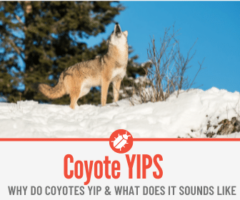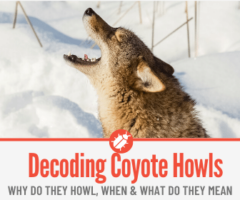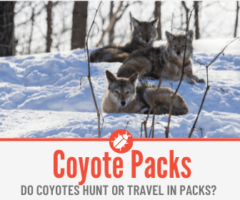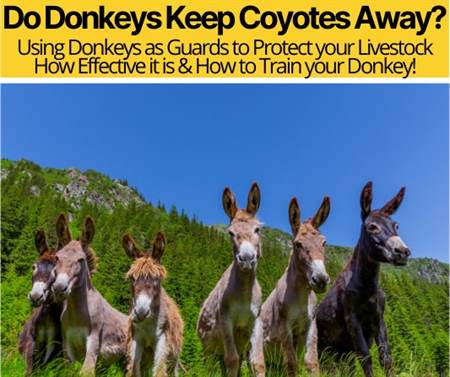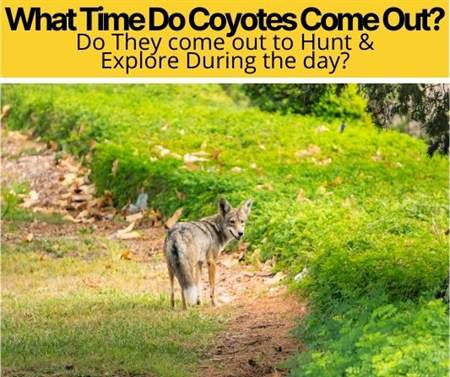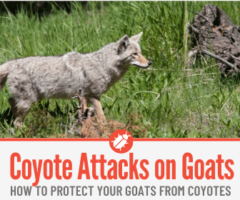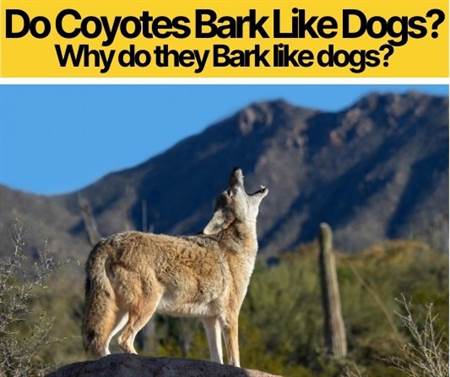 In the middle of the night, you might have heard the howls and barks of what seems to be a pack of dogs not so far from your home. These noises might actually be coyotes communicating with each other.
In the middle of the night, you might have heard the howls and barks of what seems to be a pack of dogs not so far from your home. These noises might actually be coyotes communicating with each other.
Coyotes are known as “Song Dogs” because of their complex vocalization language to send messages to other animals and their pack members, which includes many similarities with the sounds our dogs use such as howling, whining, and even, barking.
Do Coyotes Bark Like Dogs?
The lack of verbal words does not mean animals are not masters of communication. Animals use four techniques to do so: visual, tactile, auditory, and chemical. In particular, coyotes use body (visual) language to communicate with other animals or coyote mates and rivals, but they use vocalization language to pass along messages within their own species.
Coyotes are considered one of the most vocal wild mammals in North America, and while they are famous for their all-night howls, coyotes tend to bark, just like dogs do, on particular occasions, and to communicate specific situations.
Coyotes are mostly nocturnal animals that live in packs of seven to nine; as they go out to hunt, especially at night, they spread out, which is exactly why vocal language is so important amongst them.
Experts have identified eleven different vocal cues in coyotes, each one used to inform something to other pack members.
So, What Do Coyote Barks Mean?
Experts seem to think there are three fundamental reasons a Coyote would use vocal language: To alert their packs, to greet one of their own, or to connect/establish contact.
Barking enters the first category, alert. When coyotes bark it is to warn their pack from some possible, long-distance danger or disturbance, especially when they are protecting a den. Barking has also been associated with coyotes protecting their territories from intruders to scare them off.
One interesting thing that research has found is that coyotes usually bark when their packs are not so far apart, that is because their howls’ frequency reaches longer distances than a bark. Whenever the bark is immediately followed by a coyote howl, it represents a more urgent and closer danger, and it is used to alarm other members of an important threat.
Scientists also seem to believe that each message is different and personalized and it is decoded according to the duration, pitch, frequency, and intensity of the vocalization sound.
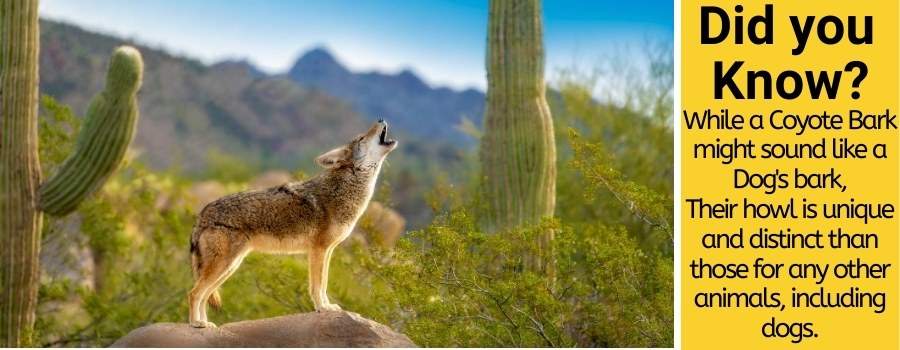
Why Do Coyotes Bark Like A Dog?
Barking is often associated with dogs, but some other species besides canids use this short but loud form of communication too: Monkeys, rodents, deer, seals, and some bird species like macaws and ostriches. However, coyotes are the only species whose bark sounds almost identical to a dog’s.
Coyotes belong to the Canidae family along with some other canids such as dogs, wolves, foxes, and dingoes. All members of this family share similarities in body forms, behavioral traits, and communication techniques.
It is quite funny because a coyote’s scientific name is Canis latrans, which is Latin to a barking dog. While barking is not a coyote’s most common trait, the combination, variety, range, and loudness of sounds a coyote can pronounce might have given them that name.
Did you knew that you can own a Coyote as a Pet? Check out this article to see how to Domesticate Coyote and keep it as a pet.
Do Coyotes Pups Bark Like Dogs Too?
Yes, from the eleven different vocalizations a coyote can make, barking is one that puppies can produce from a young age and they will probably do so playing or to warn others of possible danger, but as long as they are with their mothers they will probably only whine or yip.
For the first two months of their lives, the mother will stay with them while dad goes out for food and protects the den from danger. After the first six weeks, coyote pups will start accompanying adults on short hunting trips where they will learn to hunt and communicate with each other.
Difference Between Coyote And Dog Bark
Researchers have studied the different communication cues a coyote gives. They have been able to identify barking as a quick and loud call that sounds pretty similar to the barking of a small dog, high-pitched, and with good intensity. Ernest Thompson, author and wildlife artist, described the similarity:
“Their bark is much more distinctly like that of the domestic dog than of any other animal; in fact, the first two or three notes could not be distinguished from the bark of a small terrier, but these notes are succeeded by a lengthened scream.”
Learn more: Why Do Coyotes Yip
And What Does A Coyote Sound Like When It Barks?
Single barks (not followed by howls) are quick, high-pitched, with low-range bands (which means they are not meant to be hard at significant distances), and their frequency will rise according to the danger and urgency to warn others. If the bark is deeper with lower intensity and only a few repetitions, they are trying to ward off an intruder before attacking or running away from it.
Do Coyotes Howl Like Dogs
Just like as humans have a specific tone of voice that can be recognizable amongst others, coyotes have a distinctive howl that differentiates them from other members of their pack.
Their howl is their trademark, and it is how they mainly communicate with each other about their whereabouts or special messages when they go out hunting.
Coyotes do howl, but unlike their bark, their howl is unique and distinct than those for any other animals, including dogs.
When a coyote howls, they make distinct sounds at the same time that produces a very special effect known as beau geste; this is an auditory illusion in which the combination of sounds and tones is distorted and makes it look like a chorus, as if a pack of coyotes was howling at the same time, but in fact, it is only one single coyote (wolves do this too!).
The name of beau geste–which translates in English as a beautiful gesture- comes from the French novel in which French troops used to re-accommodate or stand fallen/dead soldiers to make it look like their force was larger and stronger to intimidate their enemies. Animals do this with the exact same purpose, to intimidate other animals.
Continue Reading: Why Do Coyotes Howl
Do They Howl At Night?
Well, they will mostly howl at night, however interaction with humans has made it a bit of a routine to howl during the day too. Coyotes are nocturnal animals, which means they are most active during the night or twilight hours than any other time of the day.
While coyotes live in packs, they usually hunt solo, in pairs, or small groups (especially if they are a family) and they can separate for 4 to 10 kilometers. Whenever they spread out or reunite, they will howl as a group to show strength in numbers, but they will also howl to find each other.
Also read: Do Coyotes Hunt During the day
Related questions.
Do coyotes howl after a kill
Coyotes mostly use howling as a way to connect with each other. After killing, they are most likely to bark to protect their fresh meal and keep off any other predator around.
How dangerous is a coyote
Coyotes do not represent an actual threat for humans, but since they are quite adaptable and instinctive creatures, they will not flight right away. They are very territorial, but they will only attack if they feel threatened (especially if they have a fresh kill or puppies to protect).
Just always remember that they are wild animals and their behaviour is almost always unpredictable, so it is better to leave them alone and avoid contact.

